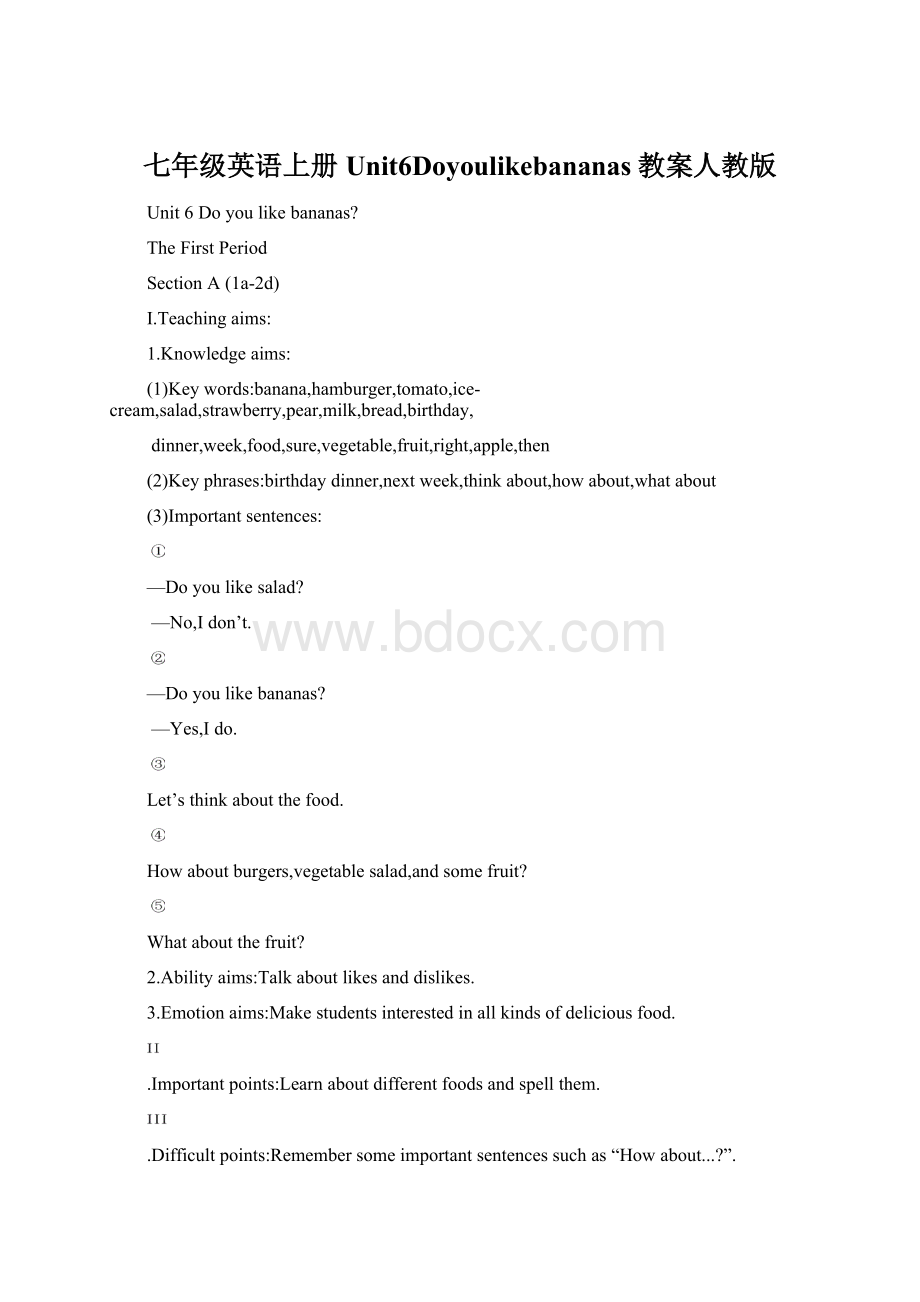七年级英语上册Unit6Doyoulikebananas教案人教版.docx
《七年级英语上册Unit6Doyoulikebananas教案人教版.docx》由会员分享,可在线阅读,更多相关《七年级英语上册Unit6Doyoulikebananas教案人教版.docx(19页珍藏版)》请在冰豆网上搜索。

七年级英语上册Unit6Doyoulikebananas教案人教版
Unit6Doyoulikebananas?
TheFirstPeriod
SectionA(1a-2d)
Ⅰ.Teachingaims:
1.Knowledgeaims:
(1)Keywords:
banana,hamburger,tomato,ice-cream,salad,strawberry,pear,milk,bread,birthday,
dinner,week,food,sure,vegetable,fruit,right,apple,then
(2)Keyphrases:
birthdaydinner,nextweek,thinkabout,howabout,whatabout
(3)Importantsentences:
—Doyoulikesalad?
—No,Idon’t.
—Doyoulikebananas?
—Yes,Ido.
Let’sthinkaboutthefood.
Howaboutburgers,vegetablesalad,andsomefruit?
Whataboutthefruit?
2.Abilityaims:
Talkaboutlikesanddislikes.
3.Emotionaims:
Makestudentsinterestedinallkindsofdeliciousfood.
.Importantpoints:
Learnaboutdifferentfoodsandspellthem.
.Difficultpoints:
Remembersomeimportantsentencessuchas“Howabout...?
”.
IV.Teachingprocess
Step1Warmingup
1.Showstudentsapictureofdifferentkindsoffood.First,letstudentssaysomewordsthatthey
knewbefore.Second,teachthemsomenewwords.
2.Teacherasksonestudent:
—Doyoulike...?
—Yes,Ido./No,Idon’t.
3.Letstudentspracticethisdialogueinpairs.
Step2Workon1a
1.Matchthewordswiththethingsinthepicture.
2.Checktheanswers.
3.Gametime!
(教师用PPT将实物逐个展示出来,同学们快速说出它是什么,第一个说出来的同学得一分)
Step3Listening
Workon1b.
1.Playtherecordingforstudentsandletthemnumberthepictures.
2.Checktheanswers.
Workon2a,2b.
1.Readthewordsthreetimesbythemselves.
2.Listenandcirclethefoodtheyhear.Checktheanswers.
3.Listenagainandtrytofillintheblanksin2b.
4.Practicethedialoguesinpairs.
Step4Pairwork
Workon1c.
Practicetheconversationswithyourpartner.
Choosesomepairstoactthemout.
Workon2c.
Step5Role-playtheconversation
Workon2d.
1.Letstudentsreadtheconversationforthefirsttime.Underlinesomekeyphrases.
2.Talkaboutthelanguagepoints.
3.Readtheconversationagainandanswerthefollowingquestions:
(1)WhatdoesJohnlike?
(2)WhatfruitdoesJohnlike?
(3)DoesJohnlikehamburgers?
Languagepoints
1.food食品;食物
通常情况下作不可数名词。
但当表示特定种类的食品时,可作可数名词,其复数形式为foods。
seafood海鲜frozenfood冷冻食品
2.chicken鸡肉
名词,作不可数名词,意为“鸡肉”;作可数名词意为“鸡;小鸡”。
Ihavechickenforlunch.午餐我吃鸡肉。
3.tomato西红柿
tomato是可数名词,意为“西红柿”,其复数形式是在词尾加-es。
Hedoesn’tliketomatoesorcarrots.他不喜欢西红柿和胡萝卜。
【拓展】以-o结尾的名词的复数
(1)有生命意义的名词加-es,如heroes(英雄),potatoes(土豆)。
(2)无生命意义的名词加-s,如pianos(钢琴),photos(照片)。
4.Doyoulikebananas?
你喜欢香蕉吗?
(教材第31页)
(1)我们常用“Do/Does...like...?
”句型来询问某人的喜好。
肯定回答一般为:
Yes,...do/does.,
否定回答为:
No,...don’t/doesn’t.。
(2)like是及物动词,它的用法有三种:
likesb./sth.喜欢某人/某物,动宾结构,宾语是名词或代词。
liketodosth.喜欢做某事
Helikestoswim.他喜欢游泳。
likedoingsth.喜欢做某事(比liketodosth.程度深)
IlikelearningEnglish.我喜欢学英语。
Exercise
1、单项选择。
1.—Dotheylikethesebooks?
—No,they________.
A.doesn’tB.don’tC.doD.aren’t
2.—________theseyourphotos?
—Yes.________youlike________?
A.Do;Do;themB.Are;Do;them
C.Are;Are;itD.Do;Are;them
3.Bob________oranges,butBill________them.
A.like;don’tlikeB.like;doesn’tlikeC.likes;doesn’tlike
4.MaryandGinadon’tlike________.
A.breadB.abreadC.breads
5.—________helikepens?
—Yes,he________.
A.Is;isB.Does;isC.Does;doesD.Is;does
2、句型转换。
1.Ilikesalad.(改为一般疑问句)
________________likesalad?
2.—Doyouliketomatoes?
(作肯定回答)
—________,I________.
3.—Doyoulikemilk?
(作否定回答)
—________,I________.
4.Ilikehamburgers.(改为否定句)
I________________hamburgers.
5.It’sastrawberry.(改为复数句)
________________strawberries.
Homework
1.Reciteallthenewwords.
2.Makeasurveyonyourfamilymembers’likesanddislikesaboutthefood.
板书设计
Unit6Doyoulikebananas?
TheFirstPeriod
SectionA(1a-2d)
①—Doyoulikesalad?
—Yes,Ido./No,Idon’t.
②Let’sthinkaboutthefood.
③Howaboutburgers,vegetablesaladandsomefruit?
④Whataboutthefruit?
教学反思:
————————————————————————————————————————————————————————————————————————————————————————————————————————————————————————————————————————————————————————————
Unit6Doyoulikebananas?
TheSecondPeriod
SectionA(GrammarFocus-3c)
Ⅰ.Teachingaims:
1.Knowledgeaims:
(1)Keywords:
egg,carrot,rice,chicken,so
(2)Keyphrases:
ask...about,getsalad
(2)Importantsentences:
—Doyoulikesalad?
—Yes,Ido./No,Idon’t.
—Doesshe/heliketomatoes?
—Yes,she/hedoes./No,she/hedoesn’t.
Ilikeoranges.
Welikerice.
Hedoesn’tlikevegetables.
2.Abilityaims:
Learntoexpress“likes”or“dislikes”with“do”or“does”questions.
3.Emotionaims:
Makestudentshavearichdiet.
.Importantpoints:
Learnaboutcountablenounsanduncountablenouns.
.Difficultpoints:
Beabletodividethefoodintocountablenounsoruncountablenouns.
IV.Teachingprocess
Step1Revision
1.Reviewthenewwords.(Flashcards:
教师闪卡片,学生快速说出是什么单词)
2.Reviewthedialogueof2bonP32.
教师出示卡片,学生根据所出示卡片练习句型:
—Doyoulike...?
—Yes,Ido./No,Idon’t.
—Doesshe/helike...?
—Yes,she/hedoes./No,she/hedoesn’t.
Step2Practice
Workon3a.
1.Choosethecorrectwordsofeachsentence.
2.Talkaboutthegrammarineachgroup.
3.Readtherightsentencestogether.
Step3Workon3b
1.Numberthesesentences[1-4]tomakeaconversation.
2.Checktheanswers.
Step4Workon3c
1.Makeasurveybyusingthetablelistontheright.
2.Makeareport.
语法拓展
名词变复数的规律
1.规则名词复数形式的构成
情况
构成方法
例词
一般情况
加-s
map→mapsbag→bagsyear→years
以s,x,sh,ch等结尾的词
加-es
bus→busesbox→boxeswish→wishes
beach→beaches
以“辅音字母+y”结尾的词
变y为i,再加-es
story→storiesfamily→familiesparty→parties
以“元音字母+y”结尾的词
直接加-s
day→dayskey→keysmonkey→monkeys
以“辅音字母+o”结尾的词
无生命的加-s,有生命的加-es
photo→photostomato→tomatoespotato→potatoes
hero→heroes
以“元音字母+o”结尾的词
直接加-s
zoo→zoosradio→radioskangaroo→kangaroos
以f或fe结尾的词
大多数变f或fe为ve,再加-s
knife→knivesleaf→leavesshelf→shelves
thief→thieves
2.不规则名词复数形式的构成
规律
例词
改变单数名词中的元音字母
foot→feettooth→teethman→men
woman→womenpoliceman→policemen
Englishman→Englishmen
单复数形式相同
JapanesesheepChinese
只有复数形式
trousersglassesclothespeoplepants
其他
mouse→micechild→children
Exercise
1、根据汉语提示填空。
1.Ilike________(水果),butIdon’tlike________(蔬菜).
2.Helikes________(草莓).
3.Hamburgersarenice.Doyoulike________(它们)?
4.Theylikesaladand________(西红柿).
5.Let’shave________(鸡肉)and________(胡萝卜).
二、单项选择。
1.Ilike________butIdon’tlike________.
A.salads;milkB.hamburger;strawberriesC.tomatoes;pears
2.—________yoursisterslikehamburgers?
—Yes,________.
A.Does;shedoesB.Do;shedoC.Do;theydo
3.Ihavesomesalad,butI________.
A.likeitB.don’tlikethem
C.don’tlikeitD.likethem
4.TomandBob________bananas.Let’s________.
A.like;havethemB.likes;hasit
C.like;hasthemD.likes;haveit
5.—IthinkAlicelikessalad.
—_______
A.Yes,shedoesn’t.B.Yes,youareright.C.Soundsboring.
Homework
1.Makeasurveyaboutyourfamilymembers’likesanddislikes.
2.ReciteGrammarFocus.
板书设计
Unit6Doyoulikebananas?
TheSecondPeriod
SectionA(GrammarFocus-3c)
—Doyoulikesalad?
—Yes,Ido./No,Idon’t.
—Doesshe/heliketomatoes?
—Yes,she/hedoes./No,she/hedoesn’t.
Ilikeoranges.
Welikerice.
Hedoesn’tlikevegetables.
教学反思:
————————————————————————————————————————————————————————————————————————————————————————————————————————————————————————————————————————————————————————————
Unit6Doyoulikebananas?
TheThirdPeriod
SectionB(1a-1e)
Ⅰ.Teachingaims:
1.Knowledgeaims:
(1)Keywords:
breakfast,lunch
(2)Importantsentences:
—DoesTomlikecarrots?
—Yes,hedoes.
2.Abilityaims:
Learnsomewordsaboutfoodandspellthem.
3.Emotionaims:
Encouragestudentstoeatmorevegetablesandfruit.
.Importantpoints:
Trainstudents’listeningskills.
.Difficultpoints:
Graspsomewordsaboutvegetablesandfruitandbeabletodescribelikesand
dislikes.
IV.Teachingprocess
Step1Review
1.Reviewthenewwordsaboutfood.
2.Listthemintocountablenouns,uncountablenouns,countableanduncountablenouns.
countablenouns:
hamburgers,eggs,oranges,bananas,apples,pears,carrots,vegetables,strawberries
uncountablenouns:
milk,bread,rice
uncountableandcountablenouns:
food,fruit,ice-cream,salad,chicken
3.Letstudentsreadthewordsandrememberthem.
4.Reviewthepluralformsofcountablenouns.
Step2Presentation
Workon1a,1b.
1.Showsomepicturesaboutbreakfast,lunchanddinner.
2.LetSsreadthefoodin1atogether.
3.Writethenumberofeachwordnexttothecorrectfood.
4.Addsomewordsaboutfruitandvegetablesin1b.
5.Checktheanswers.
Step3Listening
Workon1c.
1.Listentotherecording,circlethefoodyouhearin1a.
2.Listenagain.Fillinthechartin1d.
3.Checktheanswers.
Step4Pairwork
Workon1e.
—DoesTomlikecarrots?
—Yes,hedoes.
Letstudentsaskandanswerquestionsaboutwhattheylikeanddon’tlike.
Asksomestudentstoactouttheirconversations.
Languagepoints
1.egg鸡蛋
egg为可数名词。
因为它是以元音音素开头,所以一个鸡蛋应说anegg。
2.salad的用法
(1)若强调这种物质,为不可数名词,意为“沙拉”
(2)若指“一份沙拉”或“一盘沙拉”,则为可数名词。
Ihavesalad/asalad.我吃沙拉/一份沙拉。
【拓展】ice-cream用法与其类似,若强调该物质,则为不可数名词;若指数量,则为可数
名词。
Let’shavesomeice-cream.Pleasegivemetwoice-creams.让我们吃一些冰激凌。
请给我两份冰
激凌。
3.辨析breakfast,lunch与dinner
breakfast意为“早餐”,lunch意为“午餐”,dinner意为“晚餐;正餐”。
常用短语:
(1)atbreakfast/lunch/dinner在吃早/午/晚餐
(2)havebreakfast/lunch/dinner吃早/午/晚餐
在此短语中breakfast/lunch/dinner前面不能加冠词the或a,但可以说haveabigbreakfast,have
aquickbreakfast。
(3)havesth.forbreakfast/lunch/dinner早/午/晚餐吃……
4.可数名词与不可数名词的修饰词
(1)可数名词可以被不定冠词、基数词和形容词(如:
few,afew,many,some,any,alotof等)
修饰。
(2)不可数名词不能用冠词a,an及指示代词修饰,不能用基数词修饰。
可以用some,any,a
little,much,alotof等修饰。
Exercise
一、根据汉语或图片提示填空。
1.Ialwayshave_________(午餐)at12:
00.
2.Shehastwobananasfor_________(早餐).
3.Hedoesn’tlike_________(鸡蛋)forlunch.
4.Bobdoesn’tlike_________
.
5.Cindyhas__